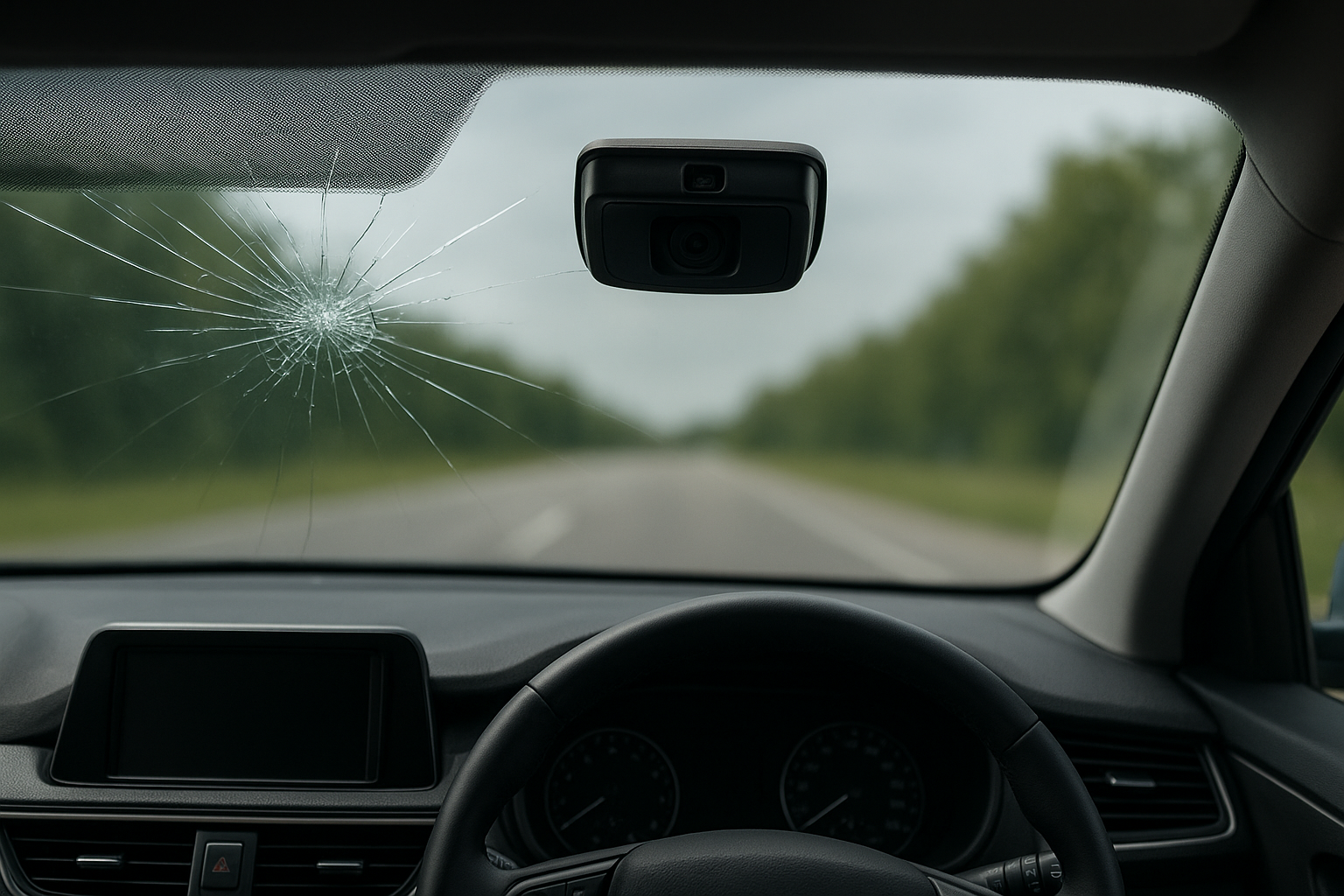Will a New Windscreen Affect Your Car's Safety Features?

When your car’s windscreen suffers damage, getting it replaced might seem like a straightforward task. However, in today’s technologically advanced vehicles, a windscreen is far more than a simple pane of glass. It has evolved from a passive barrier against the elements into a critical, active component of your car’s complex safety network. Many of the advanced safety features that drivers now rely on from lane-keeping assistance to emergency braking are directly linked to sensors mounted on the windscreen.
So, the answer is yes, a new windscreen can significantly affect your car's safety features, but only if the replacement and subsequent recalibration are handled incorrectly. When performed by skilled professionals using the right materials and procedures, a windshield replacement restores your vehicle’s full safety functionality and structural integrity. This article will guide you through how modern safety systems are connected to your windscreen, the critical role of proper installation and calibration, and what you must know to ensure your car remains as safe as the day it left the factory.
How Your Windscreen Connects to Modern Safety Systems
If your vehicle was manufactured in the last decade, it almost certainly features Advanced Driver Assistance Systems (ADAS). According to automotive studies, over 90% of new vehicles now include at least one ADAS feature. These systems are designed to enhance driver awareness and automate safety functions to prevent accidents.
Common ADAS features that rely directly on the windscreen include:
- Lane Departure Warning & Lane Assist: A forward-facing camera detects road markings to warn you if you drift out of your lane (lane departure) or actively steers the vehicle back into the centre (lane assist).
- Forward Collision Warning & Automatic Emergency Braking: This system uses cameras or radar to identify obstacles ahead. It first warns the driver and then applies automatic braking or emergency braking if a collision is imminent.
- Adaptive Cruise Control: Maintains a set distance from the vehicle in front by automatically adjusting your speed.
- Auto Headlights & Rain Sensors: Sensors mounted to the windscreen detect ambient light levels and moisture, automatically activating your headlights (auto headlights) or wiper blades.
The majority of these systems receive their crucial data from a camera and sensor module mounted at the top-centre of your windscreen. This location provides the clearest, highest forward-facing vantage point. The system interprets the road ahead through the glass, making the windscreen's optical clarity and precise sensor alignment non-negotiable for the vehicle's safety performance.
The Role of Proper Installation and Calibration
After a new windscreen is installed, the job is only half done. The crucial next step is ADAS recalibration, a process that realigns the system’s cameras and sensors to the manufacturer's exact specifications. This ensures the system receives accurate readings and functions correctly.
There are two primary methods for recalibration:
- Static Calibration: This is performed in a controlled workshop environment. The vehicle is stationary and aimed at a specific, high-tech target board. Technicians use diagnostic tools to adjust the camera's angle with millimetre precision until it aligns perfectly with the vehicle’s thrust line, as defined by the manufacturer.
- Dynamic Calibration: This method requires driving the vehicle at a specific speed on well-marked roads. A diagnostic tool is plugged into the car, and the system self-adjusts as it registers road markings. Some vehicles require a combination of both static and dynamic calibration.
A professional service will know exactly how to handle ADAS recalibration for your specific make and model. Skipping this step renders the entire ADAS suite unreliable and potentially dangerous. Even a misalignment of a single degree can cause the system to miscalculate braking distances or fail to detect lane markings correctly.
What Happens If Recalibration Is Missed
Neglecting ADAS recalibration after a windscreen replacement is not just an inconvenience; it's a significant safety risk. The long-term costs of a potential accident far outweigh the price of a proper calibration. Here’s what can go wrong:
- System Malfunctions: Lane assist may fail to engage or could steer the car erratically. Forward collision alerts might trigger for no reason (a "false positive") or, far worse, fail to trigger in a real emergency.
- Inaccurate Responses: The automatic braking system might engage too late or not at all. Adaptive cruise control could misjudge the distance to the car ahead, increasing the risk of a rear-end collision.
- Warning Lights: Your dashboard will likely display error messages related to ADAS or the front-facing camera, and in many cases, the safety systems will be completely disabled until a proper recalibration is performed.
Car manufacturers are unequivocal: recalibration is a mandatory procedure after any windscreen replacement on an ADAS-equipped vehicle to maintain optimal road safety.
Real-World Example
A customer recently brought their late-model Mazda CX-5 to a workshop after a third-party replacement. They reported that the "Smart Brake Support" and "Lane Departure Warning System" lights were flashing on the dash. The physical installation of the glass appeared correct, but a diagnostic scan confirmed the forward-facing camera was out of alignment. The previous installer had skipped the critical recalibration step. After a precise static recalibration was performed, all systems were restored to full functionality and the warning lights cleared. This common scenario underscores that a perfect glass fit is useless if the vehicle's electronic "eyes" are not perfectly realigned.
OEM vs Aftermarket Windscreens
The type of glass used for your replacement is just as important as the calibration that follows. While aftermarket glass is often cheaper, it can introduce variables that compromise safety and ADAS performance.
- OEM (Original Equipment Manufacturer) Windscreens: These are produced by the same manufacturer that made the original glass for your vehicle. They are guaranteed to match manufacturer specs for thickness, curvature, and optical clarity. This is essential for ensuring ADAS cameras can see without distortion.
- Aftermarket Windscreens: These are made by other companies. While many are high-quality, some can have subtle differences in glass composition or shape. This can distort the camera’s view, leading to calibration failures or inaccurate system performance.
For any vehicle with ADAS, it is strongly recommended to use OEM or OEM-equivalent glass. This ensures the use of high-quality materials, including multi-layered laminated glass that meets strict Australian safety standards. This type of glass is designed with a high tolerance for impact and often includes features like a UV-resistant film to protect the car's interior and the sensitive ADAS camera components from UV rays. Using Regular glass can lead to problems that even the most precise calibration cannot fix.
Common Installation Mistakes That Affect Safety
Beyond calibration, the physical installation itself demands precision. Poor installation can compromise not only ADAS functionality but also the vehicle's passive safety.
- Incorrect Adhesives: Using a low-quality or incorrect type of urethane adhesive can lead to a weak bond. This compromises the windscreen's contribution to the vehicle's structural integrity, which can be critical in a rollover accident where the windscreen helps support the roof.
- Improper Curing: The adhesive needs time to cure and form a strong, waterproof seal. Driving the vehicle too soon can disrupt this bond.
- Contamination: Any dirt, dust, or grease on the camera mounting bracket or the surrounding glass can interfere with the camera's view or the adhesive's bond.
- Ignoring the Details: A skilled professional understands that every detail matters, from the ambient temperature during installation to the cleanliness of the camera lens.
Recognizing Problems After Replacement Window Screens
After a windscreen replacement, stay vigilant for any signs that your ADAS systems are not functioning correctly. Red flags include:
- New warning lights on your dashboard.
- Lane assist or adaptive cruise control features are unavailable or behaving erratically.
- Auto headlights or automatic wiper blades are acting unpredictably.
- A noticeable delay or inaccuracy in any driver assistance alerts.
If you observe any of these issues, contact your installer immediately. Do not assume the problem will fix itself; your safety could be at risk.
Frequently Asked Questions
1. Can a new windscreen make my car unsafe?
Only if it is installed or calibrated incorrectly. A professional replacement that adheres to Australian safety standards and includes precise recalibration will restore your car’s full safety performance
2. How long does recalibration take?
It varies by vehicle, but it typically takes between 30 and 90 minutes.
3. Do all cars with a new windscreen need recalibration?
No. Only vehicles equipped with forward-facing ADAS cameras mounted on the windscreen require it. This generally includes most models from 2016 onwards.
4. Will my insurance cover the cost of recalibration?
Most comprehensive policies from major insurance companies now cover the cost of recalibration as a necessary part of the windscreen replacement process. Always check your specific policy details.
5. What is the difference between windscreen glass and rear auto glass?
While both are safety glass, the windscreen is always laminated glass for impact resistance. The rear auto glass effect on safety is different; it's typically tempered glass designed to shatter into small, blunt pieces and does not usually house ADAS cameras, meaning rear auto glass replacements rarely require recalibration.
Final Thoughts
Replacing your windscreen is no longer a simple repair it is a critical service that directly impacts your vehicle's ability to protect you. The glass in front of you is the primary lens through which your car’s most advanced safety features "see" and interpret the world.
When done correctly with high-quality materials and a mandatory, precise calibration, a new windscreen does not compromise your car’s safety; it restores it. By choosing certified, skilled professionals who understand the intricate connection between glass and technology, you ensure that every system, from lane departure warnings to emergency braking, is operating at peak performance for optimal road safety. That single decision is the most important one you can make for a safe journey ahead.
